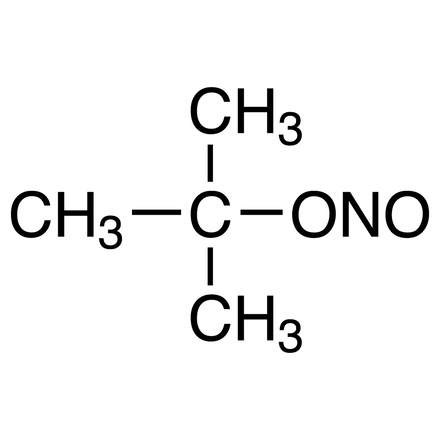Published TCIMAIL newest issue No.197
Maximum quantity allowed is 999
CAS RN: 540-80-7 | Produkte #: N0357
tert-Butyl Nitrite

Reinheit: >90.0%(GC)
- Nitrous Acid tert-Butyl Ester
| Einheit | Stückpreis | Belgien | Japan* | Menge |
|---|---|---|---|---|
| 25ML |
€41.00
|
8 | ≥60 |
|
| 250ML |
€316.00
|
4 | ≥40 |
|
*In Belgien verfügbare Lagerbestände werden in 1 bis 3 Tagen geliefert.
*In Japan verfügbare Lagerbestände werden in 1 bis 2 Wochen geliefert. (unter Ausschluss von regulierten Artikeln und Trockeneislieferungen).
| Artikel # | N0357 |
| Reinheit / Analysenmethode | >90.0%(GC) |
| Summenformel / Molekülmasse | C__4H__9NO__2 = 103.12 |
| Physikalischer Zustand (20 °C) | Liquid |
| Lagerungstemperatur | Refrigerated (0-10°C) |
| Unter Inertgas lagern | Store under inert gas |
| Zu vermeidende Bedingungen | Light Sensitive,Air Sensitive,Heat Sensitive |
| CAS RN | 540-80-7 |
| Reaxys Registrierungsnummer | 1209339 |
| PubChem-Stoff-ID | 87573709 |
| Spektrale Daten (AIST) Link | 3977 |
| Merck-Index (14) | 1583 |
| MDL-Nummer | MFCD00002055 |
| Appearance | Colorless to Yellow to Orange clear liquid |
| Purity(GC) | min. 90.0 % |
| Siedepunkt | 63 °C |
| Flammpunkt | -13 °C |
| Spezifisches Gewicht (20/20) | 0.87 |
| Brechungsindex | 1.37 |
| Löslichkeit in Wasser | Slightly soluble, Decomposes in contact with water |
| Löslichkeit (mischbar mit) | Alcohol |
| Piktogramm |



|
| Signalwort | Gefahr |
| Gefahrenhinweise | H302 + H332 : Gesundheitsschädlich bei Verschlucken oder Einatmen. H370 : Schädigt die Organe. H225 : Flüssigkeit und Dampf leicht entzündbar. |
| Sicherheitshinweise | P260 : Nebel oder Dampf nicht einatmen. P210 : Von Hitze, heißen Oberflächen, Funken, offenen Flammen und anderen Zündquellen fernhalten. Nicht rauchen. P233 : Behälter dicht verschlossen halten. P264 : Nach Gebrauch Haut gründlich waschen. P370 + P378 : Bei Brand: Trockensand, Löschpulver oder alkoholbeständigen Schaum zum Löschen verwenden. P308 + P311 : BEI Exposition oder falls betroffen: GIFTINFORMATIONSZENTRUM/Arzt anrufen. |
| EC-Nummern | 208-757-0 |
| RTECS # | RA0802000 |
| UN-Nummer | UN2351 |
| Klasse | 3 |
| Verpackungsgruppe (DOT-AIR) | II |
| HS-Nr. (Import / Export) (TCI-E) | 2920907090 |

-
Used Chemicals
-
Procedure
-
To a solution of p-anisidine (123 mg, 1.0 mmol), p-TsOH-H2O (190 mg, 1.0 mmol, 1.0 eq.), KI (415 mg, 2.5 mmol, 2.5 eq.) in acetonitrile (5 mL) was added dropwise tBuONO (0.30 mL, 2.5 mmol, 2.5 eq.) at 0 °C and the mixture was stirred at same temperature for 30 min. Then the reaction mixture was heated 60 °C and stirred for 4 h. After quenching with water (15 mL), it was extracted with ethyl acetate (15 mL x 3) and the organic layer was washed with 2 mol/L HCl aq. (15 mL), sat. NaHCO3 aq. (15 mL), brine (15 mL), dried over sodium sulfate and filtered. The solvent was removed under reduced pressure and the residue was purified by column chromatography (on silica gel, ethyl acetate:hexane = 1:4) to give 4-iodeanisole as a red solid (202 mg, 86% yield).
-
Experimenter’s Comments
-
The reaction mixture was monitored by UPLC.
-
Analytical Data
-
4-iodeanisole
1H NMR (400 MHz, CDCl3); δ 7.56 (d, J = 8.0 Hz, 2H), 6.68 (d, J = 8.0 Hz, 2H), 3.78 (s, 3H).
-
Lead Reference
-
- A New, One-Step, Effective Protocol for the Iodination of Aromatic and Heterocyclic Compounds via Aprotic Diazotization of Amines

Reference
- Benzyne Click Chemistry with in Situ Generated Aromatic Azides

1. Chlorination:1)
To a mixture of copper(II)chloride (24.35 g, 181.2 mmol), dry acetonitrile (200 mL) and tert-butyl nitrite (25.7 mL, 226.5 mmol), a solution of 4-bromo-2-chloro-5-fluoroaniline (33.9 g, 151 mmol) in dry acetonitrile (200 mL) is added at 60 ℃ under nitrogen. The mixture is stirred for 30 min at 60 ℃, followed by cooling to room temperature and addition of 2M HCl (400 mL). The phases are separated, and the water phase is extracted with diethyl ether (150 mL). The combined organic phases are washed with water and dried over MgSO4. The organic phase is concentrated on the rotary evaporator and is distilled at 150 ℃/ 20 mbar, yielding colourless oil (30 g, 111 mmol, 72% yield, 90% purity).
Anhydrous copper(II) bromide (6.8 g, 30.5 mmol), tert-butyl nitrite (4.3 mL, 36 mmol), and anhydrous acetonitrile (150 mL) are added to a three-neck round-bottom flask, and the mixture is heated to 65 ℃. 2,7-Diamino-9,10-anthraquinone (2.9 g, 12 mmol) is added slowly over a period of 5 min to the reaction mixture. Nitrogen is evolving during the reaction. After nitrogen evolution have subsided, the reaction mixture is cooled to room temperature and poured into an aqueous 20% HCl solution (100 mL). The crude solid product is collected, washed with ether, and chromatographed on a silica gel column (hexane : CH2Cl2 = 1: 1) to afford the desired product (2.6 g, Y.60%) as a yellow solid.
References
- 1)Synthesis of Dioxin-like Monofluorinated PCBs: for the Use as Internal Standards for PCB Analysis.
- 2)Arylethynyl Substituted 9,10-Anthraquinones: Tunable Stokes Shifts by Substitution and Solvent Polarity.
Artikel / Broschüren
Sicherheitsdatenblatt (SDB)
Das angeforderte SDB ist nicht verfügbar.
Bitte Kontaktieren Sie uns für mehr Informationen.
Spezifikationsdokumenten
AZ & andere Zertifikate
Muster-AZ
Ein Muster-AZ für dieses Produkt ist zur Zeit nicht verfügbar.
Analytische Diagramme
Das angeforderte Analysediagramm ist nicht verfügbar. Wir entschuldigen uns für die Unannehmlichkeiten.





